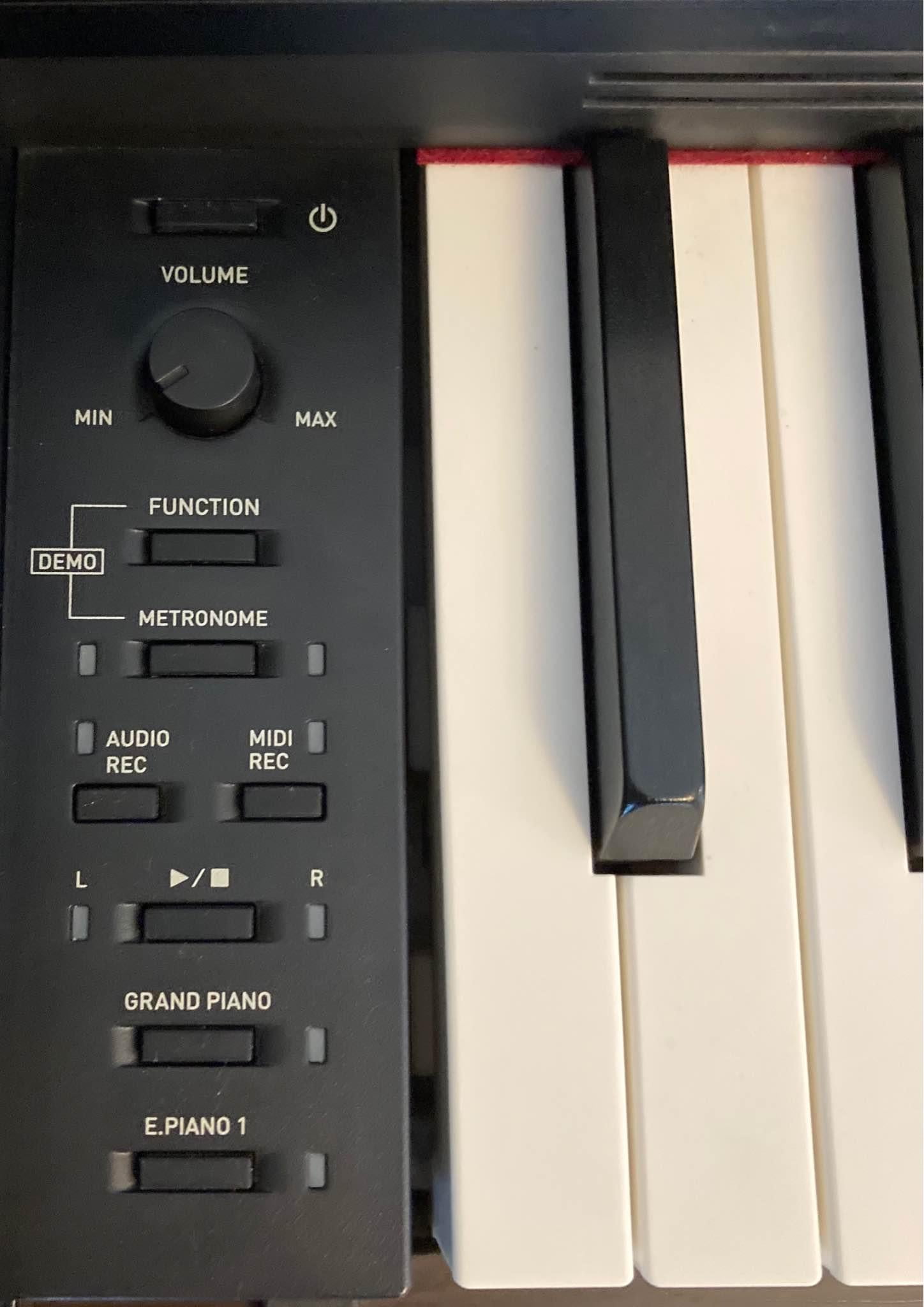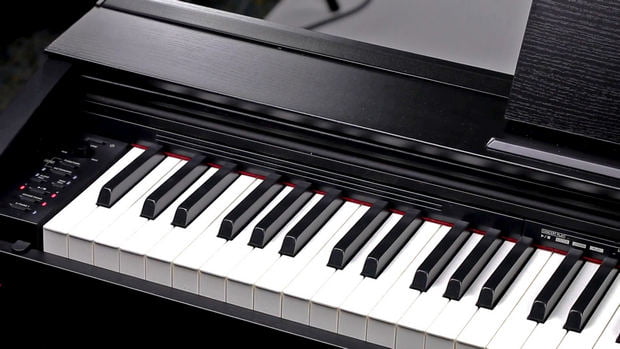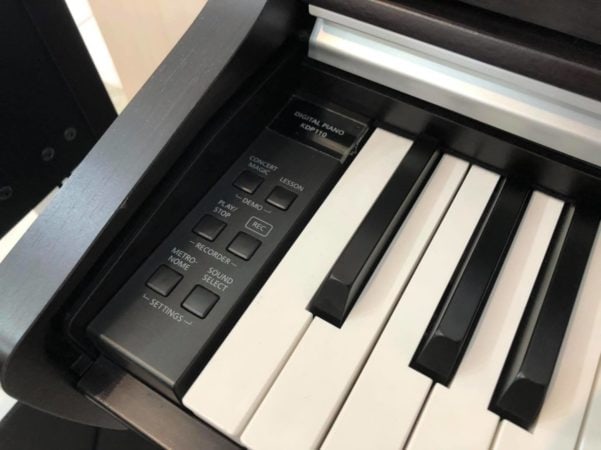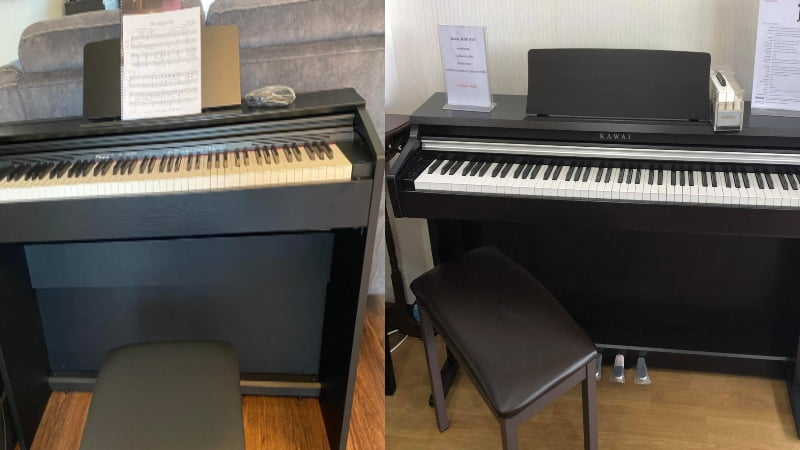Learn which model is worth your time and money in this Casio PX-870 vs Kawai KDP-110 review.
When shopping for digital pianos, the $1,000-$1,500 price range is a good place to start. These pianos have a bunch of high-quality and top-tier features, but you won’t have to bust the bank just to get your hands on one.
And in this price range, the Casio PX-870 vs Kawai KDP-110 debate is one that rings on in musician circles. Since both of these pianos are considered some of the top options in the sub-$1,500 range, comparing these two pianos was a whole lot of fun.
After an in-depth comparison though, I had to choose a winner. And because it featured a better feel and wider sound library, I ended up choosing the Casio PX-870 as the winner.
This doesn’t mean that the KDP-110 isn’t worth your money. However, if you’re looking for more value and versatility with your digital piano, the Casio PX-870 is the obvious pick.
Casio PX-870 vs Kawai KDP-110: Comparison Chart




Last update on 2025-07-09 / Affiliate links / Images from Amazon Product Advertising API
Casio PX-870 vs Kawai KDP-110: The Features
The way I found a winner between the two was a head-to-head feature comparison. I put each of the features up head to head against each other, and the final score was 3-1 in favor of the Casio PX-870. While it looks like the Casio PX-870 easily beat the Kawai model, that wasn’t the case.
If you go through the details of the review, you’ll find that the Kawai KDP-110 put up a very close fight, but the Casio was still able to narrowly edge out the competition in two different categories.
Tone
The winner: Casio PX-870
My first consideration in this comparison was the tone. After all, if you’re spending over a thousand dollars on a piano, you would at least expect it to sound good. Luckily, both of these pianos came with very rich and accurate tones. However, I ended up choosing the Casio PX-870 because of its more versatile sound library.
+Tone Generation
The Casio PX-870 runs on the AiR Sound Source while the Kawai KDP-110 runs on Harmonic Imaging. If you strip these generators to their bare bones, both pianos basically use samples to generate tones. However, Casio and Kawai made sure to do everything they could to enhance the quality of these samples.
Kawai accomplished this by loading each and every key with high-quality samples recorded from their own Kawai pianos. The only problem with the sampling method for tones is that you need high-quality samples to produce realistic tones. Kawai understood the assignment perfectly and made sure that the Kawai KDP-110 features some of the best samples on the market.
The Casio PX-870 is loaded with 4-layer samples. This produces a much richer and well-rounded tone. The AiR Sound Source is designed to use complex and dense samples so that the soundwaves travel through the air more accurately.
Since both pianos are loaded with great tone engines, you don’t need to worry at all when it comes to sound quality. While they won’t exactly be the best sounding pianos on the market, they far exceed the expectations of their price range.

+Sound Library
The real decider in this comparison was the sound library. The Casio PX-870 features 19 unique voices while the Kawai KDP-110 only features 15 unique voices. Now, this isn’t an incredibly large difference, but it does give you a few more options if you choose the Casio model.
With that said, both pianos feature the same voice categories. You get a selection of a variety of piano, electric piano, strings, bass, and organ voices. For a digital console piano, this is a pretty fair selection since there are a lot of models out there that only have around 5 different voices.
Again, both pianos give you a fair amount of versatility. But if you’re particular about your tone and enjoy having a wide range of options, the Casio PX-870 is the better option overall.
Feel
The winner: Casio PX-870
Both of these pianos are loaded with different hammer action systems. But when testing them out, I found that they both performed pretty well. However, the main difference was in the key texture, and that’s where the Casio PX-870 excelled and why it ended up taking the point.
+Hammer Action
The Casio PX-870 uses the Scaled Hammer Action II System and the Kawai KDP-110 uses the Responsive Hammer Compact II. Both of these systems are at around the same level, and the difference between the two isn’t that big.
In fact, both of these hammer action systems are designed to accomplish the same goal. So, regardless of the piano you choose, you can expect heavier keys on the left side compared to the right side, which is a major plus for any pianist of any skill level.
I tried out both of these pianos myself. And to be honest, there was barely a difference. Since they’re in the same price range, they have a similar set of features, even if the technology underneath is very different.
+Key Texture

The key texture is the main reason the Casio PX-870 ended up taking the cake. The Casio model features coated white and black keys. These keys are designed to resemble the texture of the ebony and ivory keys on an acoustic piano.
In this price range, most pianos only feature glossy plastic keys. While most beginners won’t notice the difference, the more you play the instrument, the more glaring it becomes. So, I was pleasantly surprised by the key texture on the PX-870.
With that said, the Kawai KDP-110 also features textured keys, but not to the same extent as the PX-870. The KDP-110 only goes as far as a matte finish on the keys. This is definitely better and feels more comfortable than glossy plastic keys, but I have to admit that it didn’t feel as realistic as the Casio PX-870.
Piano Features
The winner: Tie
While the Casio PX-870 narrowly edged out the Kawai KDP-110 in the other categories, I couldn’t find anything to separate the two in terms of piano features. They both have their own positives and drawbacks, so they split the point when it came down to the piano features.
+App Integration
One of my favorite features on the Kawai KDP-110 was the app integration. If you download the partner app of the Kawai KDP-110 on your phone, you unlock a bunch of different features.
To start, you can select different voices and tones on your phone. But aside from that, you can even edit certain parameters of different tones so they really suit your tastes. This is a great feature for people who really need a specific tone to perform properly.
Right now, the Casio PX-870 doesn’t support app integration. As useful as the feature is, it’s not exactly a requirement for most pianists, so it wasn’t a priority for Casio. However, it still would have been nice to see some sort of app integration for a smoother user experience with the Casio PX-870.

+Effects
When it comes to effects, the Casio PX-870 won out over the Kawai KDP-110. A major complaint I had with the Kawai model was the lack of effects. Again, effects aren’t necessary for a good tone, but it does provide pianists with a bit more control.
That’s why I really enjoyed the chorus, reverb, and brilliance effects on the Casio PX-870. As a pianist, these are all the effects you’ll need to create textured and full tones that stand out when you perform.
This won’t be too useful for beginners as it’s always best to focus on developing the proper technique before you go ahead tweaking and experimenting with tones. However, it is nice that the Casio PX-870 comes with built-in effects that can provide you with a bit more control over your tone.
Casio PX-870 vs Kawai KDP-110: The Similarities
As two digital console pianos, both of these models share a fair range of similarities. For starters, they both feature a three-pedal unit. Granted, the Kawai KDP-110 has a more sophisticated system, but they do about the same thing and provide pianists with a way to be more expressive in their playing.
On top of that, they have fairly basic speaker systems. This isn’t a flaw at all, however, since the speakers on both pianos are fairly loud and are more than enough for practicing alone or jamming with friends.
Additionally, they are both full-key digital pianos. So, you have the entire range of notes you can expect from an acoustic piano with realistic hammer action. That means both of these pianos will serve any pianist really well.
However, I ended up choosing the Casio PX-870 as the winner in the end because it has a bit more versatility than the Kawai KDP-110.
Quick Rundown of the Casio PX-870
- TRUE PIANO FEEL & EXPRESSION – 88-key Tri-Sensor II Scaled Hammer Action delivers authentic touch with simulated ebony and ivory textures, offering remarkable feel and superior dynamic control.
- IMMERSIVE GRAND PIANO SOUND – The AiR Sound Source delivers rich detail with advanced damper and string resonance, key-off simulation, and mechanical sounds—recreating the full depth of a concert grand.
- POWERFUL 40W SOUND SYSTEM – 4-speaker Sound Projection system fills your space with rich, immersive sound, plus Headphone Mode for quiet practice.
- The Tri-Sensor Scaled Hammer Action II keyboard has an incredible feel and captures the dynamics of a performance with unparalleled speed and accuracy
- BUILT FOR LEARNING – Duet Mode, dual headphone jacks, 60 built-in songs, 2-track MIDI recorder, and Concert Play with orchestral backing tracks.
Last update on 2025-07-09 / Affiliate links / Images from Amazon Product Advertising API
Quick Rundown of the Kawai KDP-110
Last update on 2025-07-08 / Affiliate links / Images from Amazon Product Advertising API
Product Videos
Related Articles to Casio Px 870
- Casio PX-870 vs PX-850: Finding the Best Privia Piano
- Casio PX-870 vs AP-470: What Makes the AP-470 Different?
- Casio PX-870 vs Casio AP-650: Which Casio Should You Get?
- Casio PX-870 Vs AP-270: Which Console Digital Piano Should You Get?
- Casio PX-870 Vs Yamaha YDP-163: Which Digital Piano Is The Better Option?
- Casio PX-870 Vs Yamaha YDP-143: A Look At Two Top Digital Console Pianos
- Casio PX-870 Vs Yamaha P-125: Should You Get A Portable Or Console Digital Piano?
- Casio PX-870 Vs Roland F140R: Which Is The Better Piano?
- Casio PX-870 Vs Roland FP-30: Which Piano Should You Choose?
- Casio PX-870 Vs 860: A Battle Of Two Privia Pianos
- Casio PX-870 Vs Roland RP102: Which Is The Better Console Digital Piano For Beginners?
- Casio PX-870 Vs PX-780: Which Casio Model Is Best For You?
- Casio PX-870 Vs Yamaha YDP-164: Which Is The Better Choice For Beginners?
- Casio PX-870 Vs Yamaha YDP-144: Which Is The Better Console Digital Piano?
- Casio PX-770 Vs 870: Which Casio Console Digital Piano Is Better?
Related Articles to Kawai Kdp 110
- Yamaha YDP-144 vs Kawai KDP-110: Why the YDP-144 Is the Better Piano
- Casio PX-770 vs Kawai KDP-110: The Best Console Digital Pianos on a Budget?
Reference:
- Casio PX-870: https://www.pianodreamers.com/casio-px870-review/
- Kawai KDP-110: https://www.digitalpianoreviewguide.com/kawai-kdp-110-review-better-than-the-kdp-90/
Lulacruza is an electronic folk duo operating at the junction of the hypermodern and the ancient. Our music weaves together hypnotic female singing, South American folk instruments and electronic processing, while channeling pulsating waves from the source of creation.
Lalucruza is also a community where you can connect with other music lovers to collaborate, exchange ideas and share knowledge. A platform for who wants to learns the basics of playing piano, guitar, drum masters’ technique, etc.. is the premise of our website.
